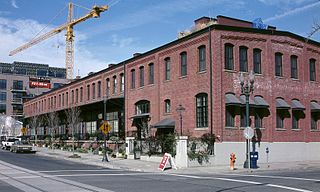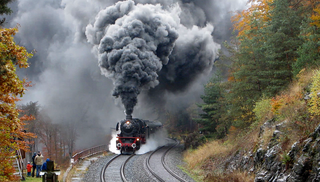
The Empire Builder is an Amtrak long-distance passenger train that operates daily between Chicago and – via two sections west of Spokane – Seattle and Portland. Introduced in 1929, it was the flagship passenger train of the Great Northern Railway and its successor, the Burlington Northern, and was retained by Amtrak when it took over intercity rail service in 1971.

The North Coast Limited was a named passenger train operated by the Northern Pacific Railway between Chicago and Seattle via Bismarck, North Dakota. It started on April 29, 1900, and continued as a Burlington Northern Railroad train after the merger on March 2, 1970 with Great Northern Railway and the Chicago, Burlington and Quincy Railroad. The next year, it ceased operations after the trains which left their originating stations on April 30, 1971, the day before Amtrak began service, arrived at their destinations.

Spokane, Portland & Seattle 700 is the oldest and only surviving example of the E-1 class 4-8-4 Northern type steam locomotive. Nearly identical to the A-3 class Northerns built for Northern Pacific Railway, it burns oil instead of coal.

The Spokane Intermodal Center is an intermodal transport facility located in Spokane, Washington, United States. It serves as a station, re-fueling, and service stop for the Amtrak Empire Builder, as well as the Greyhound, Trailways, and Jefferson Lines station for Spokane. The Empire Builder provides service daily between Chicago, Illinois and Spokane before continuing on to Seattle, Washington or Portland, Oregon.

The Northern Transcon, a route operated by the BNSF Railway, traverses the most northerly route of any railroad in the western United States. This route was originally part of the Chicago, Burlington and Quincy Railroad, Northern Pacific Railway, Great Northern Railway and Spokane, Portland and Seattle Railway systems, merged into the Burlington Northern Railroad system in 1970.

Burlington Northern Railroad Bridge 9.6 or BNSF Railway Bridge 9.6, also known as the Columbia River Railroad Bridge, is through truss railway bridge across the Columbia River, between Portland, Oregon, and Vancouver, Washington, owned and operated by BNSF Railway. Built by the Spokane, Portland and Seattle Railway (SP&S) and completed in 1908, it was the first bridge of any kind to be built across the lower Columbia River, preceding the first road bridge, the nearby Interstate Bridge, by a little more than eight years.
The SP&S Class A-1 steam locomotives were a group of 5 identical locomotives. They were used in the rail yards at Portland, Oregon, and Vancouver, Washington, from 1907 to 1952. They were replaced with diesel-electric switch locomotives.
Spokane, Portland and Seattle Railway's Class A-3 was a class of 0-6-0 steam locomotive switchers.
Spokane, Portland and Seattle Railway Class L-1 was a class of 4-4-0 steam locomotives built in 1889 by Schenectady Locomotive Works.
Spokane, Portland and Seattle Railway's Class L-2 was a class of 4-4-0 steam locomotives.
The Spokane, Portland and Seattle Railway (SP&S) class L-4 steam locomotives were originally used by the Astoria and Columbia River Railroad (AC&R). They became SP&S locomotives when the SP&S acquired the A&CR.
Spokane, Portland and Seattle Railway Class L-5 was a class of 4-4-0 steam locomotives built in 1897 by Schenectady Locomotive Works.
On the American Spokane, Portland and Seattle Railway, locomotive number 525 was the only steam locomotive in SP&S class O-2. It was originally built for Northern Pacific by the Schenectady Locomotive Works. Builders number 46878 was built in February 1910.

Spokane Portland and Seattle Railway’s E-1 class was a class of the only three 4-8-4 locomotives built by the Baldwin Locomotive Works in 1938. The E-1 class northerns were very identical to the A-2 through the A-5 class northerns on the Northern Pacific Railroad built by the Baldwin Locomotive Works from 1934-1943. No differences by eyes of people were noticed. The only difference is that the Northern Pacific Railroad 4-8-4s burn coal, and the 4-8-4s on the Spokane, Portland & Seattle Railroad burns oil.

SS Northern Pacific was built as a passenger ship at Philadelphia by William Cramp & Sons under supervision of the Great Northern Pacific Steam Ship Company for the Spokane, Portland and Seattle Railway Company. Northern Pacific, along with sister ship Great Northern, were built to provide a passenger and freight link by sea between the Great Northern Railway Lines and Spokane, Portland and Seattle Railway terminal at Astoria, Oregon and San Francisco beginning in spring of 1915. The ship was acquired on 17 September 1917 for use as a transport ship for the United States Navy during World War I, commissioned USS Northern Pacific and later, after transfer to the United States Army, as the Army transport USAT Northern Pacific. She was destroyed by fire in 1922.

The North Bank Depot Buildings, located in central Portland, Oregon, United States, are a pair of buildings formerly used as a freight warehouse and passenger terminal for the Spokane, Portland and Seattle Railway (SP&S). Formed in 1905, the SP&S was commonly known as the North Bank Road during the period in which these buildings were in use. The Portland buildings' passenger facilities were also used by the Oregon Electric Railway after that railway was acquired by the SP&S. Located in what is now known as the Pearl District, the buildings were listed on the National Register of Historic Places in 1996. They were in use by the SP&S and its successor, Burlington Northern Railroad, from 1908 until the 1980s. Only the east building was used as a passenger station, and this usage lasted from 1908 until 1931.

The Oregon Slough Railroad Bridge, also known as the BNSF Railway Bridge 8.8, is a swing-span, through truss bridge in Portland, Oregon, United States. Currently owned and operated by BNSF Railway, it crosses an anabranch of the Columbia River known as North Portland Harbor and historically as the Oregon Slough. The bridge's northern end is on Hayden Island, which, along with Tomahawk Island, forms the north shore of the channel. Completed in 1908, the two-track bridge is one of only two swing bridges surviving in Portland, which once had several bridges of that type, both for road and rail traffic. The only other remaining swing bridge in the Portland area is another rail-only bridge on the same line, BNSF's nearby Bridge 9.6, spanning the Columbia River.

The Expo '74 was a passenger train operated by Amtrak between Spokane and Seattle, Washington. It operated in the summer months of 1974 in coordination with its namesake, Expo '74. With the addition of the Expo '74 to the Empire Builder and North Coast Hiawatha, Amtrak provided thrice-daily service between Seattle and Spokane, the highest level seen since Amtrak's formation and unmatched since.











